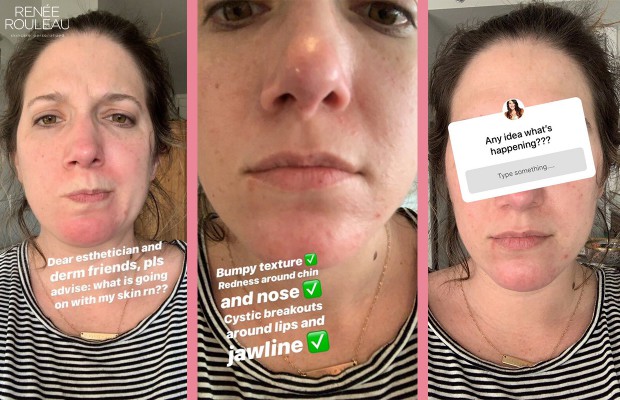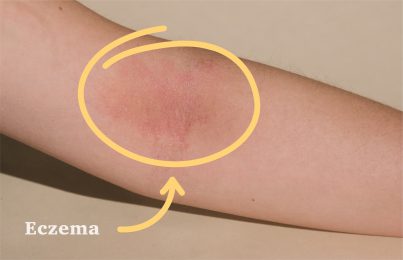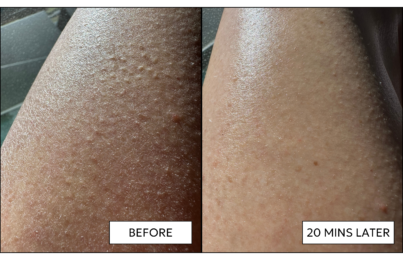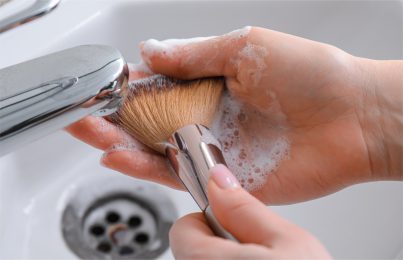Updated 02/22/22. Every winter, people contact me and say, “The skin on my face, chin, and neck is getting rough, dry, and red. What do you think this is from?” I always say that when the skin flares up, there are so many factors to consider—not just the products you’re using, but your lifestyle and daily habits as well.
What Could Be the Cause of This Winter Face Rash?
When I saw this cry for help from Lindsey, a beauty editor, on Instagram, I had to step in and try to figure it out for her. I knew she was in New York where the weather was 14° F and windy, so I asked her this simple question: “Have you been wearing a wool scarf to cover your face?” She immediately replied back, “OMG, yes!” and attached a photo of her scarf’s label, which read “100% wool.” So there you go. It turns out her wool scarf was the cause of this face rash.
Why Does a Wool Scarf Cause a Face Rash?
Your skin has a barrier that’s made up of natural lipids that help keep moisture in and irritants out. When this barrier is damaged (due to extreme cold, dry climates, over-exfoliation, or any of these other reasons), tiny, invisible cracks appear in the skin. These cracks allow moisture to escape, which leads to dryness and flakiness.
When wool or a wool-like material rubs against this already-vulnerable skin, the fibers create friction, which acts as an additional irritant. This exacerbates the problem and causes an inflammatory response. For Lindsey, it manifested as red bumps that she initially thought were breakouts. Can you imagine if she then started drying out her skin with harsh, breakout-focused products? That would have made things so much worse!
It doesn’t just happen on the face, either. Wool can be particularly irritating on the neck since the skin is naturally thin in that area. So, you might want to think twice before reaching for a wool scarf or turtleneck! For some people, wool is even known to trigger eczema and perioral dermatitis flare-ups.
What’s the Best Way to Prevent a Winter Face Rash?
Obviously, you’ll want to avoid wearing clothing made of wool or any other scratchy-feeling material. That’s especially true when it comes to clothing items like turtlenecks and scarves that will be close to your face and neck. Instead, choose materials that feel soft to the touch.
If you have a favorite wool scarf that you just don’t want to give up, avoid wrapping it too close to the skin. For many people, simply having this newfound awareness allows them to position their scarf in a way that prevents an uncomfortable face rash.
How Can You Fix a Winter Face Rash?
If you’re experiencing a winter face rash with red bumps, like Lindsey, there are four steps you can take to fix it.
1. Put the Fire Out
First, you want to soothe your skin and get rid of that uncomfortable irritation. Once you remove the cause (in this case, wool clothing items), you can minimize the appearance of red bumps by using a soothing, gel-based mask. I recommend the Rapid Response Detox Masque. It’s specifically formulated to soothe surface redness and irritation while targeting bumps and breakouts.
2. Strengthen Your Moisture Barrier
Make sure you’re supporting your skin’s barrier by using a well-formulated moisturizer after cleansing and toning. This will help seal up invisible cracks, helping your skin return to its normal state. Just be sure to use one that’s suitable for your specific skin type. (If you don’t know your skin type, take the Skin Type Quiz. At the end of it, you’ll see your skin type along with personalized product recommendations.)
3. Simplify Your Routine
The less you do to your skin while it’s irritated, the better. Go back to basics and stick to a simple routine. Use a gentle cleanser, an alcohol-free toner, and moisturizer (one with sunscreen during the day and one without sunscreen at night). Stick to this simplified routine until the rash subsides.
4. Stop Using Active Ingredients
Any time your skin is irritated, you’ll want to temporarily discontinue the use of products that have acidic properties or exfoliate the surface layers of the skin and stimulate cell turnover. While active ingredients like vitamin C, exfoliating acids, and retinol play an important role in keeping your skin smooth, they can compound irritation when your skin is sensitive. Avoid using these ingredients until the rash subsides and you feel like your skin is back to its normal state.
Next, read up on the five most common winter skin mistakes to avoid!
Celebrity Esthetician & Skincare Expert
As an esthetician trained in cosmetic chemistry, Renée Rouleau has spent 30 years researching skin, educating her audience, and building an award-winning line of products. Her hands-on experience as an esthetician and trusted skin care expert has created a real-world solution — products that are formulated for nine different types of skin so your face will get exactly what it needs to look and feel its best. Trusted by celebrities, editors, bloggers, and skincare obsessives around the globe, her vast real-world knowledge and constant research are why Marie Claire calls her “the most passionate skin practitioner we know.”



